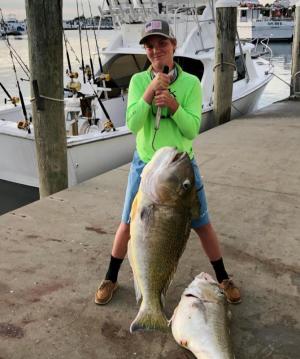Young angler catches large golden tilefish
On June 21, 13-year-old Dylan Baker came to the dock at Hook ’em and Cook ’em on board the Eire Mar with a very large golden tilefish. In fact, it turned out the 52.8-pounder is now the pending Delaware state record for that species. But, that’s not the end of the story. Along with the state record, Dylan also cranked up another golden tilefish that weighed 32 pounds. Believe me, that’s a lot of fish to bring up from the bottom of the canyon.
Big flounder and trout
We are seeing some big flounder caught over ocean structure. Rick’s Bait and Tackle checked in a 9.4-pound flounder for Matt Pry and a 7.2-pounder for Anthony Arcidiacono over the weekend. In addition, we are seeing 5- and 6-pounders caught regularly from charter and head boats working the Old Grounds. A variety of baits from squid to Gulp! have been employed either on flounder rigs or on jigs.
One of the biggest trout we have heard of in years was caught from the fishing pier in Cape Henlopen State Park. Dave Beebe at Lighthouse View Tackle checked in the 5.1-pound beauty for Erik Duong. The fish was caught on a live spot.
Boats fishing reef sites in Delaware Bay are finding keeper-sized trout on a regular basis. Certainly not in the numbers we had back in the day, but much better than recent seasons.
Offshore
Pick a canyon, from the Wilmington to the Norfolk, and you should find the tuna waiting. Limit catches of yellowfin, while not common, have been made. Bigeyes are there as well, but do require heavier tackle to land in a reasonable amount of time. White and blue marlin have been released.
Bottomfish
The sea bass action has remained steady, with the bulk of the keepers caught farther offshore. Some remain at the Old Grounds and are caught along with the flounder.
In Delaware Bay, kings and spot are caught from the fishing pier at Cape Henlopen State Park on bloodworms or FishBites. Lower Bay reef sites hold the same fish plus the occasional flounder and trout.
Flounder and trout remain in the Lewes-Rehoboth Canal. Gulp! and live minnows are the two most popular baits here.
If I am any indicator of surf fishing, it is pretty bad. I went up on Three Rs Road early Monday morning fishing the incoming into the outgoing and never had so much as a nibble. I keep hearing reports of kings and blues caught from the beach, but you can’t prove it by me.
Indian River Inlet gives up blues and hickory shad during the last of the incoming water. This I have had success with by casting a two-ounce Stingsilver with a shad dart eight inches behind and catching shad with some consistency. At night, rockfish to 50 inches have been caught and released by anglers tossing live eels, big plugs and shads. Last week, the Coast Guard Station was the hot spot, but then it moved to the South Jetty. You just have to be in the right place at the right time.
Flounder fishing in the Back Bays is slow. Having fished there for many years, I suggest getting out before sunrise and fishing where the tide and wind allow. Live minnows and Gulp! will be your best baits.
A few tips
When fishing the deeper waters of the ocean and bay, use the lightest line that is practical. Braid is best in this situation, but there is no need to fill the reel with this expensive line. If you put on 100 yards of 20-pound braid with the rest of the reel filled with 30-pound monofilament, you will cut down on the expense and still have 300 feet of braid to fish in 100 to 150 feet of water. It is important to fish with a full reel because this allows you to retrieve more line when cranking up the fish. On spinning reels, a full spool will mean longer casts.
Use enough weight to maintain contact with the bottom. When drifting, you should keep raising and lowering the rod tip to bounce the sinker on the bottom and feel the difference between mud, sand and hard structure. When you first feel the hard structure, crank up a few feet of line to keep the sinker out of the rubble. Carefully drop back down and use a light touch to keep feeling the bottom and staying just above the snags.
Try a bucktail with a strip of squid, or one of the FishBites or Gulp! products. This combination can produce some of the largest sea bass and flounder when worked just above the bottom structure.

























































